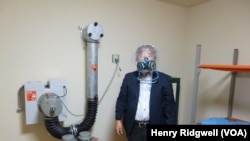In the quiet town of Kotoura on Japan’s western coast, children practice baseball and soccer on the school grounds, while elderly residents tend to the summer rice harvest.
Suddenly, the scene is punctured by a piercing siren and loudspeaker announcements warning of an incoming missile from North Korea. The residents run for cover inside buildings or behind walls.
'It is very scary'
Evacuation drills like this recent one are being conducted in communities all along the Japan Sea coast. The Japanese government believes civil defense exercises could save hundreds of thousands of lives in the event of an attack. For the people taking part, it is a sobering experience.
“It is very scary. When I’m with my children, I can protect them, while I can’t do anything if I’m at work and away from them. I’m afraid of that,” said Kotoura resident Akiko Kodani, a mother of two children at the local school.
Japan is readying its “J-alert system”, a series of emergency messages relayed over loudspeakers, mobile phones and computers. Missile defense systems have been deployed in western Japan.
North Korea has test-fired more than a dozen missiles into the Japan Sea this year, with some landing inside Japan’s economic zone. Defense analysts think Pyongyang is on the brink of producing nuclear weapons it can deliver on missiles.
Many here fear that as an ally of the United States, Japan could be targeted or get caught in the crossfire of any conflict.
Fallout shelters
Some Japanese are taking their preparedness a step further.
Hidden in the forested hills of central Japan, Kenji Oribe has built what he believes will help him survive any nuclear conflict in East Asia.
His construction company Oribe-Seiki Seisakusho specializes in building underground shelters. With the rhetoric of war building in North Korea, Oribe has seen a big rise in demand.
“The blast-proof doors, the escape hatches, and the machines like this air pump are all imported from Switzerland. Now there is a shortage of these components, and I have to ask my customers to wait a little,” Oribe told VOA during a visit to his shelter outside the city of Kobe.
The shelter’s ventilator filters out noxious gases and radiation, giving its occupants long enough to survive the radiation following a nuclear attack. It can be operated manually if the power fails. Inside the shelter are all the essentials for life underground: beds, exercise machines, cans and boxes of nonperishable food, plenty of water and gas masks. An escape hatch offers an alternative exit in case the house above is destroyed.
“With the atomic bombs that fell on Hiroshima and Nagasaki, the radiation levels fell to one-thousandth of the original level after two weeks. So it was safe to go outside. Two weeks is the globally accepted standard,” Oribe said.
His shelter is partly a showcase for potential customers. But it is clear Oribe shares their concerns.
“It is embarrassing that Japan was defeated 72 years ago in the Second World War, it unconditionally surrendered, and it still has yet to take care of its own security,” he said. “If there is a next war, I do not want to lose.”
Oribe and his customers believe they are investing in survival, but safety like this doesn’t come cheap. A shelter costs about $165,000, but his order book is filling fast.













